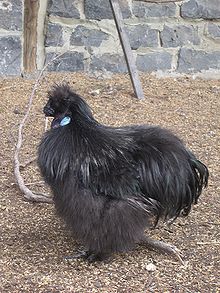Silk hen
| Silk hen | |
|---|---|

|
|
| BDRG - Standard No. | |
| origin | East asia. |
| year | Detectable in the literature for almost 700 years. |
| Colours | white, black, blue, pearl gray, yellow, red, splash, sparred , wild-colored, silver-wild-colored, white and black-spotted, each with a beard |
| Weight | Tap 1.4 to 1.7 kg
Hen 1.1 to 1.4 kg |
| Laying performance | 80 eggs |
| Eggshell color | Light brown |
| Egg weight | 40 grams |
| food | Grass, worms, grains |
| Life expectancy | about 5 years |
| List of breeds of chicken | |
The silkie is a breed of domestic chicken . There are different forms of the silk fowl: the Japanese silk fowl with black skin and the Siamese silk fowl with white skin as great silk fowl and also as dwarf silk fowl .
history
Despite much evidence in the literature and through other traditions, the exact origin remains unclear. However, it is authentic that the Venetian merchant and travel writer Marco Polo reported after a trip to Mongolia and China in 1292 of black chickens, which he described as cat-haired. Later the Swiss naturalist and writer Conrad Gessner described the silk fowl in his bird book published around 1555 as snow-white woolly chickens with black skin, which are known in China. Another record from 1793 refers to the occurrence of the silkie in Holland , Westphalia and Burgundy . From that time there is also a reference to traveling showmen who demonstrated silk chickens as a cross between chicken and rabbit at annual fairs .
Appearance
Silk chickens are slightly smaller than normal chickens. Male silkies have a mulberry-shaped crest.
The peculiarities of the silkie are their five toes and the black-blue skin. Their feathers appear frayed and fur-like. This is because the contour feathers missing the hooks beams at the side branches that normally connect the springs to a contiguous area. In addition, the feathers of the silkies have a soft shaft. Therefore they are flightless and are suitable for low fenced enclosures . Their colored feathers are also sold for handicrafts in the craft store.
The ear discs are bright turquoise blue. The currently recognized plumage colors are white, black, blue, pearl gray, yellow, red, splash, sparrowed, wild-colored and silver-wild-colored (formerly known as silver-gray). As with all other chicken breeds, the blue color is split. In the breeding of this color, when mating blue x blue there are approx. 25% black, 50% blue and 25% splash-colored offspring. Other special characteristics are the hood-like crest on the head and the plumage that extends to the feet. This is a short fletching of the legs and the outer toe. A silk hen lays around 80 eggs a year. Silk chickens are very good and reliable breeders. There are a total of three breeds of silkie, large silkie, dwarf silkie, and of both types also those with a beard. These are then called bearded silkies.
behavior
The silk hen is a social hen that, with a lot of patience, can quickly become trusting or tame. The hens are good chicks because they raise and warm the chicks together. They are also less aggressive than other hens. Despite the plumage, not every silkie hen stays away from the rain (even in the colder seasons). A roof to protect against rain, however, would be recommended in the open air.
Space requirement
Since silkies are smaller than other breeds, they take up at least half the space that a normal chicken needs. Of course, 1 m² per chicken in the barn is better, 5 m² is sufficient for the outdoor area.
literature
- Frank Peschke, Günter Droste: Seidenhühner und Zwerg-Haubenhühner , 6th revised edition, Verlag Oertel + Spörer, Reutlingen, 2017, ISBN 978-3-88627-552-6 .
